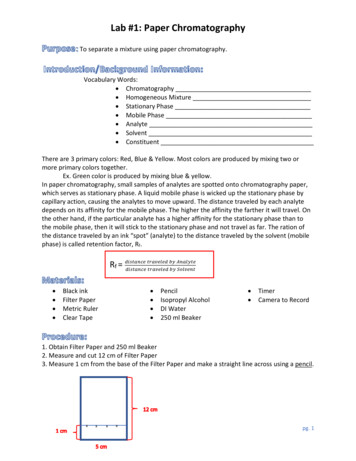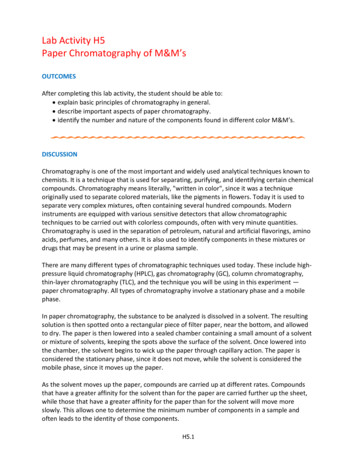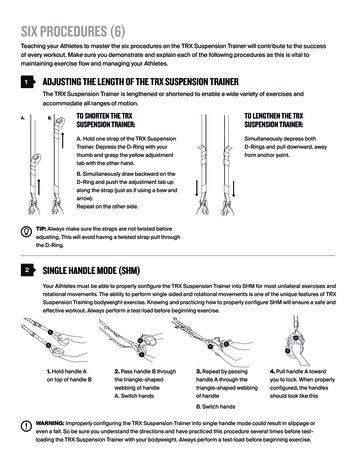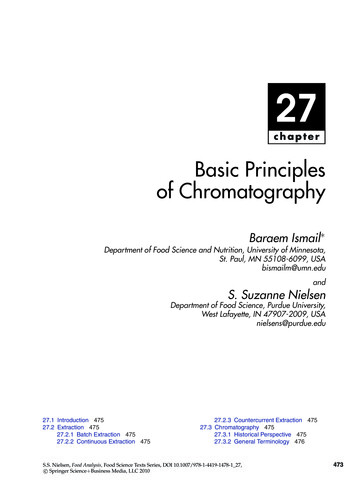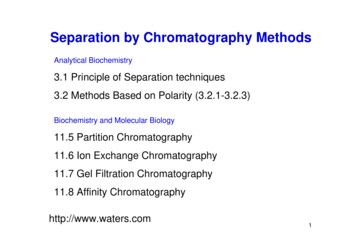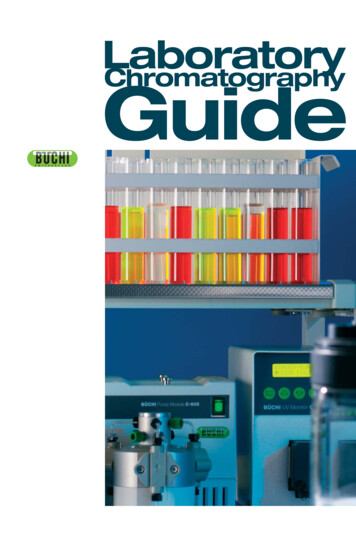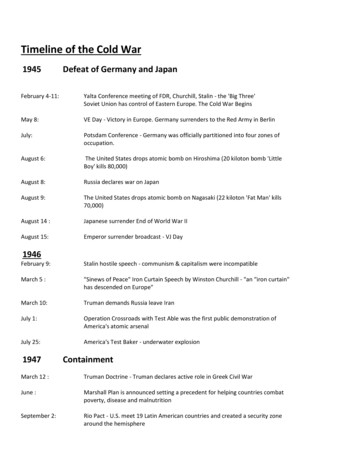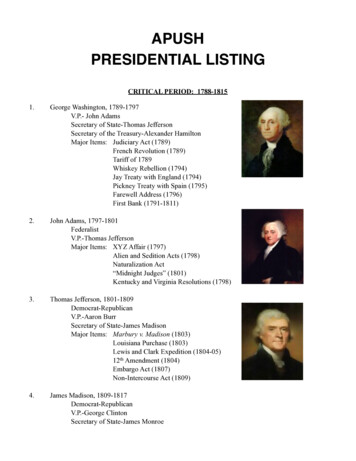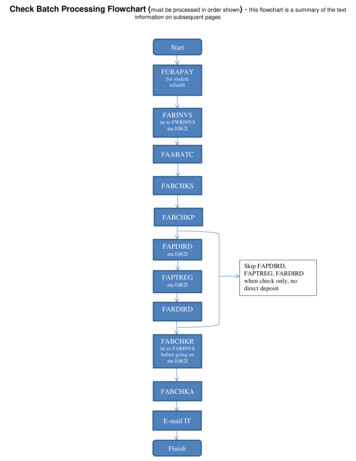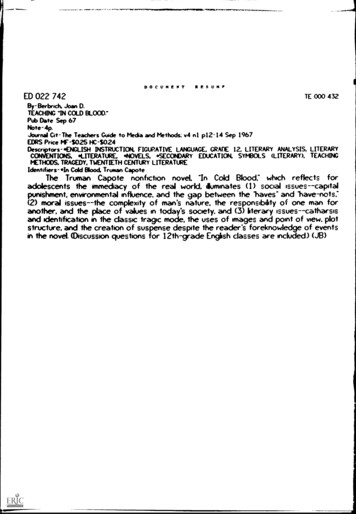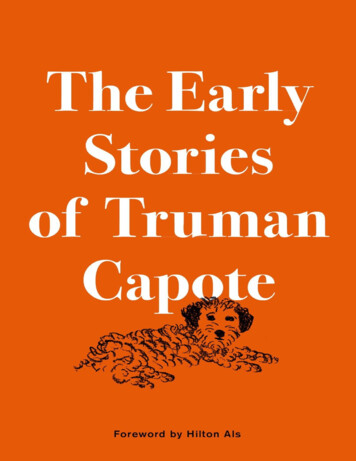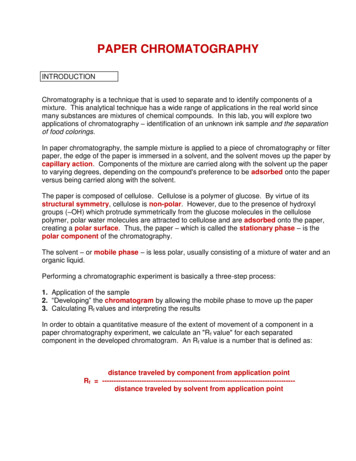
Transcription
PAPER CHROMATOGRAPHYINTRODUCTIONChromatography is a technique that is used to separate and to identify components of amixture. This analytical technique has a wide range of applications in the real world sincemany substances are mixtures of chemical compounds. In this lab, you will explore twoapplications of chromatography – identification of an unknown ink sample and the separationof food colorings.In paper chromatography, the sample mixture is applied to a piece of chromatography or filterpaper, the edge of the paper is immersed in a solvent, and the solvent moves up the paper bycapillary action. Components of the mixture are carried along with the solvent up the paperto varying degrees, depending on the compound's preference to be adsorbed onto the paperversus being carried along with the solvent.The paper is composed of cellulose. Cellulose is a polymer of glucose. By virtue of itsstructural symmetry, cellulose is non-polar. However, due to the presence of hydroxylgroups (–OH) which protrude symmetrically from the glucose molecules in the cellulosepolymer, polar water molecules are attracted to cellulose and are adsorbed onto the paper,creating a polar surface. Thus, the paper – which is called the stationary phase – is thepolar component of the chromatography.The solvent – or mobile phase – is less polar, usually consisting of a mixture of water and anorganic liquid.Performing a chromatographic experiment is basically a three-step process:1. Application of the sample2. “Developing” the chromatogram by allowing the mobile phase to move up the paper3. Calculating Rf values and interpreting the resultsIn order to obtain a quantitative measure of the extent of movement of a component in apaper chromatography experiment, we calculate an "Rf value" for each separatedcomponent in the developed chromatogram. An Rf value is a number that is defined as:distance traveled by component from application pointRf --------------------------------distance traveled by solvent from application point
The distance traveled by the spot is measured to the MIDDLE of the spot.Solvent FrontRf A/BBAPencil MarkForensic chemistry, the profession popularized by TV's "CSI," is the application ofchemical techniques to law. Many samples that are received in a crime laboratory arecomplex mixtures of chemical compounds, and chromatography is often ideal forseparating and identifying these components. One example of this is the identificationof an unknown ink sample. Suppose the authenticity of a signature or the source of aransom note is in question. Using paper chromatography, it is often possible to identifythe source of the ink that was used and thereby provide strong evidence that can beused in the courtroomIn the second part of the experiment, you will separate a mixture of three food coloringsusing "reverse-phase" chromatography. In this type of chromatography, the stationaryphase is a non-polar material and the mobile phase is relatively polar. You will usea commercial C18 cartridge, which contains very non-polar 18-carbon long chains as thestationary phase. The mobile phase will be water and/or isopropyl alcohol (IPA).TECHNIQUESUsing chromatography paper stripsAVOID EXCESSIVE HANDLING OF PAPER – WEAR GLOVES!1.The chromatography paper is cut in about 2.5 x 10 cm strips. Along one of theshorter sides, draw a horizontal line in pencil (lead will not move) about 1.5 cmfrom the edge of the strip. This will be your “base line,” the starting line wherethe samples will be spotted.2.Apply a spot of ink from each color of each brand of felt tip pen on the baseline.[Each pair of students will use two strips of chromatography paper, one for eachbrand of color inks.] Make sure spots are evenly spaced on the baseline andnot too close to the edge.
3.Use a pencil to label the spots; the graphite from the pencil will not move with ordissolve in the solvent. See the diagram below. Stand the paper in the elutingsolution in a 400 ml beaker. Taping the top of the strips to the side of the beakermay be helpful.Base Line123
Using C18 Cartridge1.Remove the cartridge from the bottom of the syringe, and then remove the pistonof the syringe.2.Insert the LONGER END of the C18 cartridge snugly onto the syringe tip. Becareful to use the proper end and not put the cartridge on backwards.3.Add solution as directed and insert the piston.4.Flush solutions S-L-O-W-L-Y through the cartridge. Faster is NOT better.5.REMOVE CARTRIDGE BEFORE PULLING PLUNGER to add new solution toavoid pulling air backwards through the column.6.The cartridge should be cleaned with a 1:1 mixture of water:IPA until allcoloring is removed. Food coloring not removed may stain the column andmake it less effective.SAFETY AND DISPOSAL The food coloring mixture will stain your skin and clothing. Handle with care.All of the solutions in this lab may be washed down the drain with plenty of water.EXPERIMENTAL PROCEDUREI.Identification of Inks by Paper ChromatographyA.This lab will be done as a collaboration between both lab pairs at a table.1. One lab pair will use 2 parts isopropyl alcohol to 1 part water as asolvent (labeled 2:1 IPA).2. One lab pair will use 1 part isopropyl alcohol to 2 parts water as asolvent (labeled 1:2 IPA).B.Each lab pair obtains two strips of chromatography paper about 2.5 cmwide by 10 cm tall. Along one of the shorter sides, draw a horizontal linein pencil about 1.5 cm from the edge of the strip. This will be your“base line,” the starting line where the samples will be spotted. Graphitewill not be carried up the chromatography paper. This baseline will beused later in the calculations of Rf values.
C.Using the color felt tip pens, apply generous spots of ink on the baseline oneach strip of chromatography paper, one strip of paper for each brand. Thereare three colors of ink for each brand, so you are applying three spots of inkon each piece of chromatography paper.D.With a pencil, label each dot with the identity of the pen from which the ink came.E.Obtain a paper strip from your instructor that is marked with ink from one of thesix pens. This is the unknown ink sample that you must identify. The unknownmay be distributed after you have begun developing your “known”chromatograms.F.Once your two strips of “knowns” are prepared, set up a “developing chamber”using a 400 ml beaker.1. Pour some of the developing solvent (2:1 IPA OR 1:2 IPA) in the beaker,using only enough solvent to cover the bottom of the beaker (about 5-10 mL).2. Remember, one lab pair will use 1:2 IPA and the other lab pair will use 2:1IPA.G.Place the paper strips into the developing chamber so that the edge near the inkspots is submerged in the solvent. THE INK SPOT MUST BE ABOVE THESOLVENT LEVEL. You should avoid allowing the paper strips to touch eachother or the sides of the beaker. (Taping the top of the strips to the outside of thebeaker may be helpful.) Once you have inserted the paper, make sure thesolvent is progressing up the paper.H.When the solvent has stopped moving up the strips, remove the strips fromthe beaker and place them inside a folded paper towel to remove excess solvent.Then, with the assistance of the instructor, mark the level to which the solvent hasrisen and circle each component present on the strip with a pencil.I.Measure the distance each component has traveled and calculate Rf valuesfor each component. [Use the circles you drew around each spot with yourpencil and not the actual spot!]J.Turn your chromatogram in as part of your report on your Data Sheet.
II.Separation of Food ColoringsA.Remove the piston and insert the LONG END of the C18 cartridge snugly intothe syringe tip.B.Add 5 mL of IPA, insert the piston, and S-L-O-W-L-Y flush at a flow rate notexceeding 5-10 mL per minute. It is important to not flush liquid through thecartridge more rapidly than 10 mL per minute.C.Flush with a 5 mL portion of distilled water.D.Add about 1 mL of the food coloring mixture to the syringe, insert thepiston, and S-L-O-W-L-Y push the mixture onto the cartridge. As you push thesample through the cartridge, immediately begin collecting the colored drops ina test tube. The first color comes off quickly.1.Once the 1 mL of food coloring mixture is pushed onto the cartridge, addwater to the syringe and push it through the cartridge until all the yellowis gone. Collect the yellow liquid. The process of pushing solvent(s)through a cartridge is called elution. In this case, water elutes theyellow color.2.The remaining colors in the mixture must be removed by eluting with awater/IPA mixture. You must be patient here! Prepare a 1% IPAsolution by placing 5 mL of water into the syringe and adding 1 drop ofIPA. Mix well by shaking the syringe. Push this solution through thecartridge and collect all the colors that come off. If coloring still remainson the cartridge, prepare a 2% IPA solution by adding 2 drops of IPA to 5mL of water, mix, and elute this solution through the cartridge. Continueto increase the percentage of IPA (3% - 3 drops IPA 5 mL water, 4% 4 drops IPA 5 mL water, etc.) until all or most of the coloring has beenremoved from the cartridge. A 5% IPA solution may be the mostconcentrated solution needed to remove all of the colors from thecartridge.3.Any coloring residue remaining on the cartridge must be removed usinga 1:1 IPA-to-water mixture, or by using pure IPA. This residue may needto be collected. (You’re cleaning up here.)4.Save the separated colored solutions for the next part.E.See what would happen if several of the separated colored solutions weremixed. For example, try to make a green solution from the colors youseparated.F.Make sure the cartridge is white as driven snow before returning it.
polar component of the chromatography. The solvent – or mobile phase – is less polar, usually consisting of a mixture of water and an organic liquid. Performing a chromatographic experiment is basically a three-step process: 1. Application of the sample 2. “Developing” the chromatogram by allowing the mobile phase to move up the paper 3. Calculating R f values and interpreting the .
